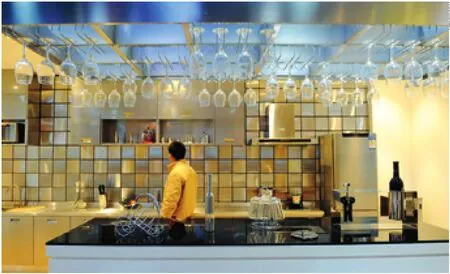Steelmakers’ Late Spring
2012-10-14LiuXinlian
Steelmakers’ Late Spring
China’s fragmented and overcrowded steel industry finds ways to bolster profits By Liu Xinlian

STERLING STEEL:A worker commands lifting of steel rolls in the finished parts storage of the Shanghai-based Baosteel Group, China’s largest steelmaker
Wuhan Iron and Steel Corp. (Wusteel), the country’s fourth largest steelmaker based in central China’s Hubei Province, recently announced a plan to build a 10,000-head pig farm as part of a diversification strategy. It’s going to invest 39 billion yuan ($6.19 billion) in swine, poultry and vegetable farms in 2012.
“It is hard to make money by making steel,” said Deng Qilin, President of Wusteel.“Steel prices are much lower than pork. To survive, we have to diversify,” he said.
Wusteel’s decision to raise pigs has astounded the public. Actually, Wusteel is not the only steelmaker diversifying. According to the Shanghai-basedNational Business Daily, half of China’s major steelmakers have made inroads into the housing industry.
What is behind steelmakers’ diversifying efforts are losses in the steelmaking industry.
The collective profit margin for the Chinese steel industry has fallen to 3 percent over the past two years, well below the 6-percent average for other industrial sectors, according to the Ministry of Industry and Information Technology (MIIT).
According to statistics from the China Iron and Steel Association (CISA), the profit margin of the Chinese steel industry was less than 1 percent in the fourth quarter last year, representing a loss across the sector.
China’s major steel producers saw further losses in January this year, and the losing streak is expected to continue throughout the year.
The country’s 80 largest steel producers reported combined losses of 2.32 billion yuan ($366.80 million) in January, compared with a net profit of 7.91 billion yuan ($1.26 billion) in the same period last year, according to the CISA.
With margins for steel mills being squeezed by soaring iron ore prices and a softening of domestic demand, China’s steel industry is not likely to pick up soon.
In response, steelmakers need to upgrade their production and pronounce a stronger and more unified voice in international iron ore price negotiation, said Zhang Changfu, Vice Chairman of CISA.
Multiple reasons
As a growth engine of the global economy for more than a decade, China’s appetite for iron ore has increased dramatically over the past decade.
In 2000, the country imported 69.97 million tons of iron ore. Last year, that number surged to 686 million tons, according to China Customs figures.
Mysteel.com, a Chinese Internet portal for the iron and steel industry, estimated China will import as much as 720 million metric tons of iron ore in 2012.
Despite being a big purchaser, China does not have much bargaining clout and has actually pushed up global iron ore prices with its large demand.
China Customs statistics show imported iron ore prices for China reached $163.8 per metric ton in 2011, up 27.1 percent from a year ago.
In 2012, prices will remain between $130 and $150 per metric ton, according to a report by Guangdong-based Guosen Securities.
However, rising imports will leave China with little room to reduce its dependence on imported iron ore next year, said Zhao Xiang’e, an analyst with Guangdong-based Huatai United Securities.
Macroeconomic slowdown is also blamed for the slump in the steel industry.
“Last year, China’s GDP growth slowed as a result of economic restructuring, which caused consecutive decreases in the manufacturing sector and fixed-asset investment,” said Zhang.
Government efforts to rein in a speculative commercial real estate boom also dampened the demand for steel.
While China’s steel sector was suffering from losses, the investment frenzy in the industry continued.
Last year, fixed-asset investment in China’s steel industry reached a record high of 511.1 billion yuan ($81.13 billion), according to the MIIT.
According to Deng, domestic demand for steel is 500 million tons and the real production capacity is 690 million tons.
“Domestic steel industry faces a serious overcapacity problem,” Deng said.
What has made the steelmakers feel even more gloomy is the fact that 80 percent of the production capacity is concentrated in plain product types, including deformed steel bars, wire rode, medium plate and hot rolling plate.
Before 2000, the Shanghai-based Baosteel, China’s largest steelmaker, was the only producer of automotive steel sheets, but today, at least seven companies could produce the same product and more steelmakers are vying to make inroads into this field.
“Steelmakers should be encouraged to develop their own advantageous product types and avoid swarming into the same products,”

STEEL FOR DAILY LIFE: A tourist visits a model kitchen mainly made of stainless steel in the exhibition hall of Taiyuan Iron & Steel Group Co. Ltd. in north China’s Shanxi Province
said Luo Tiejun, Deputy Director of Raw Material Department of the MIIT.
Unclear prospects
“An increase in steel demand in March was expected and steel mills are eager to lift prices after producing at marginal profits or making losses over the past few months,” said Hu Zhengwu, an analyst with Beijing-based industry consultancy Custeel.com.
The price hike will make the business operations of Chinese steelmakers easier, said Hu Yanping, another analyst with Custeel. com.
Industry insiders, however, said that there were no grounds for optimism.
“In 2012 the steel industry will face an even more severe test—weak demand will make the supply-demand gap even wider and high prices of raw materials like iron ore will continue to put pressure on profits,” said Zhu Jimin, Chairman of Shougang Group based in north China’s Hebei Province.
For Deng of Wusteel, the hardest time for China’s steel sector was not this year.
“I think China’s steel sector will go through tough times for the next at least five years. On one hand, steelmakers have to face mounting costs; on the other hand the slowdown in economic growth will make many industries wane. Hope for making profit is very slim,” Deng said.
In order to rally the steel industry, the Chinese Government plans to increase the proportion of the output of the top 10 steelmakers from 48.6 percent to 60 percent through merger and acquisition during the 2011-15 period.
“The consolidation of small steel enterprises will help them survive the hard times, avoid disordered competition and optimize product structure,” said Zhang Lin, an analyst with Beijing Lange Steel Information Research Center.
The fragmented industry is also blamed for China’s vulnerable position in international iron pricing negotiations.
“It is hard for numerous Chinese steelmakers to present a unified voice in international negotiations with the major iron ore suppliers,” said Wang Shoudong, President of Taishan Steel Co. Ltd. in east China’s Shandong Province.
